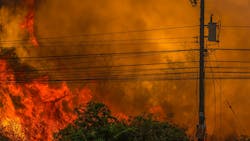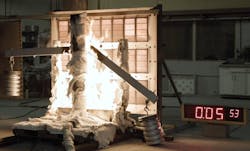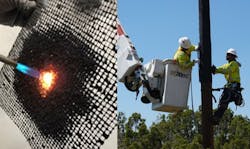Materials Science & Wood Pole Protection
Wildfires always have been a part of our environment. For a variety of reasons, in recent years wildfires have been growing in both frequency and intensity, dramatically increasing the level of property damage they cause.
For utilities, this is a pressing challenge. Millions of poles carry thousands of miles of distribution lines through highly susceptible grasslands and forests, leaving utilities particularly vulnerable. Facing heightened demands for fewer, shorter and less disruptive power outages, the stakes are high. Utilities must now focus significant resources on efforts to mitigate the risks wildfires pose.
Material Choices
Some utilities believe switching from wood structures to other materials such as composite fiberglass or steel will protect those structures from wildfire damage. On its face, that strategy may seem logical — after all, wood does burn. But the reality is the material used for poles and crossarms has little to do with whether those structures will survive a wildfire intact. Wood, steel, ductile iron, concrete or composite fiberglass, no material is impervious to fire’s impacts.
The intense heat and flames from wildfires can easily compromise the structural integrity of any pole material, leading to failures that disrupt power distribution. When failures also result in live wires coming in contact with previously unscorched ground, it can ignite new fires, exacerbating the situation.
Ironically, in many instances wood structures are the most likely to survive fire damage intact, a particularly important consideration as existing systems are tasked with carrying ever-increasing loads from wires, transformers and other equipment.
When wood burns, a char layer forms that can protect the inner fibers, thereby allowing the wood to retain much of its strength. New technologies designed to further protect wood poles from burning, and thus retaining their structural integrity, are proving effective, not only in the research lab, but also through actual experience on the ground.
Heat in Wildfires
Research shows temperatures in advancing wildfires can reach as high as 2,200ºF. Heat that intense will significantly impact any material’s structural properties. Steel, for example, begins to lose strength at about 400ºF. It retains just 80 percent of its strength at about 575ºF and fully half of its strength is lost by the time it reaches 932ºF.
Similarly, composite fiberglass also can quickly lose strength when exposed to wildfire conditions. While concrete will not burn in a fire, the elevated temperatures can cause both mechanical and chemical changes in the aggregate compounds as well as the steel rebar, weakening the structure.
Evidence of the destructive forces wildfires can inflict on all materials is clearly seen in photographs depicting the aftermath of severe fires. Cars and poles made of steel and iron are burnt shells of twisted, melted metal.
Fire Performance Testing
The primary function of utility poles and crossarms is to carry the weight of conductor lines, transformers and other equipment. The key to resiliency is understanding how materials behave under abnormal conditions, such as those associated with wildfires — will they remain able to perform that function? That understanding can be attained through material performance testing.
Due to their size, full-scale fire testing of utility poles is extremely difficult. However, smaller scale tests can offer valuable insights into how fire impacts a pole material’s structural integrity.
Tests comparing the fire performances of preservative-treated wood and composite fiberglass crossarms are telling. In 2022 and 2024, the Western Fire Center in Kelso, Wash., tested both materials using ASTM standard pole test protocols adapted for crossarms to simulate real-world wildfire conditions. The crossarms were attached to a pole stub and 300-lb. weights were suspended from each end to simulate the loads they carry in use. Sample crossarms of each material were exposed to a combination of heat sources, including radiant heat and open flames.
In the first test, crossarms were exposed to radiant heat panels for five minutes, followed by exposure to a convective flame burner for an additional five minutes. The second test exposed the crossarms only to the convective flame burner for a total of 10 minutes. In both tests, after the radiant heat and flame exposures, the crossarms were allowed to continue burning and/or self-extinguish for 20 minutes longer.
Results conclusively proved the superior fire performance of preservative-treated wood. In the tests using both radiant panels and the flame burner, the composite fiberglass crossarms all collapsed less than six minutes into the test. Using only the flame burner the best-performing composite crossarm failed after just five minutes and 10 seconds.
In 2024, the Center applied the same test to another brand of composite fiberglass crossarms. They lost their ability to carry the 300-lb. loads in under four minutes. In some instances the radiant heat alone caused the “non-combustible” composite fiberglass crossarms to ignite.
By comparison, the wood crossarms in all the tests remained intact for the entire 30 minutes. Preservative-treated wood crossarms, some with an added fire-retardant coating, some without, were tested with similar results. All ignited and charred but continued to hold up the 300-lb. weights throughout the test period.
The results indicate that under real-world fire conditions, lines held aloft by wood crossarms are far more likely to remain in place, continuing to carry electricity, than if the lines had been supported by fiberglass crossarms. Keeping lines aloft and capable of delivering power can be the difference between a lengthy power outage or no outage at all.
Crossarms and poles are decidedly different, but both carry significant loads as part of their function. It is not a leap in logic to assume poles of different materials will react to fire exposure in a manner similar to crossarms.
Marketing Claims or Actual Performance?
The crossarm fire test results underscore the critical difference between what composite pole marketers claim and how their products might actually perform during fire. To tout the fire resistance of their products, composite fiberglass pole promoters cite standards that appear to be official but in fact are somewhat dubious.
Articles in energy trade journals promoting composite poles have cited “V-O self-extinguishing” ratings, per Underwriters Laboratories’ UL 94, a standard developed for “Tests for Flammability of Plastic Materials for Parts in Devices and Appliances.” With stakes as high as they are, it’s a stretch to apply a standard intended for testing the parts in “devices and appliances” when assessing how composite fiberglass poles and crossarms might perform in a fire.
UL itself cautions that UL 94 is intended only for small-scale material tests, as it involves exposing small samples (5-inch by ½-inch) to a burner flame. In a bulletin confirming the standard’s applicability, UL states: “The scope of UL 94 clearly indicates it does not cover polymeric materials used for building construction …” UL also notes the standard is intended for “end-use manufacturers of electrical equipment and products that are required to use UL 94-rated materials for their factory production.”
The composite fiberglass pole industry’s own research underscores the threat posed by fire exposure. According to the Center for Integration of Composites into Infrastructure (CICI), fiber-reinforced polymer (FRP) poles lose 25 percent of their strength when exposed to high temperatures for less than 30 seconds. At peak wildfire temperatures, CICI reports, an outer layer of fiberglass burns off every minute, noting, “after several more minutes of severe fire exposure, the FRP poles fail.”
Steel Poles and Fire
While the impacts of high temperatures on the structural capabilities of steel are well-known, wildfires can affect the long-term performance of steel structures in other ways as well. Steel poles often are galvanized, with a layer of zinc applied to the surface to protect the underlying steel from rust and other deterioration.
With a melting point of only 419ºF, far below the temperatures steel poles would be expected to face in a wildfire, that protective coating can melt away, leaving the steel structure intact, but exposed. Over time, that exposure can create corrosion which can significantly impact steel’s tensile strength and make it more brittle. This can lead to catastrophic failure of the entire structure at a time when utilities may be least prepared for it.
Protecting Wood Poles
With millions of wood poles in place, utilities are smart to focus efforts on protecting poles in service, and adding protection to new poles they purchase. A variety of technologies designed to do that have been developed in recent years.
One such technology, fire-retardant pole wraps, is proving to be a particularly effective, and economical, way to provide added fire protection for wood poles. Pole wraps consist of a wire or fiberglass mesh covered with an intumescent coating. The mesh is flexible enough that it can easily wrap around poles without losing its structural integrity. When exposed to heat, the intumescent coating expands to create a protective, insulating barrier between the fire and the wood. These wraps can be applied to poles in the field using common tools and the labor required is minimal compared to installing replacement poles.
Once installed, protective pole wraps are durable, not prone to wildlife damage, and can withstand extreme weather. They also allow line workers to climb wood poles with standard climbing gear, as boot gaffs can easily penetrate through the wraps into the wood pole without damaging the mesh.
Fire Wrap Performance
Utilities in the West are using pole wraps such as Fire Mesh™ by Genics, which offers a 23-gauge wire mesh as well as a fiberglass-based mesh, and Armorbuilt™ Wildfire Shield from Hexion which uses a fiberglass-based mesh. Both products have undergone extensive testing to confirm their effectiveness in protecting poles from fire damage.
Southern California Edison, a utility serving some 15 million people across parts of 13 counties in central, coastal and southern California, recently completed in-field tests of the Genics Fire Mesh™ wrap technology. Full-length poles wrapped with the mesh were exposed to fire for two and three minutes, then were full-scale break tested to determine if the fire had any impacts on pole strength. Results showed pole strength was reduced by less than 2 percent after fire exposure.
In 2022, the California Dept. of Forestry and Fire Protection tested poles wrapped in Hexion’s Armorbuilt™ Wildfire Shield mesh. The poles were subjected to a controlled burn in a high intensity fire-risk area near Salinas, Calif.
Poles located in the burn area endured flames as high as 45 feet and temperatures that reached 1,700ºF. Inspections conducted after the fire revealed the poles had “no damage, superficial charring or appearance change” after the wraps were removed.
These results have been confirmed through real-world experiences. Fire-retardant-mesh-wrapped wood poles were in the path of the 2020 Lake Fire near Los Angeles, which burned 31,000 acres. After the fire, the utility, Southern California Edison, examined the poles for damage. The mesh-wrapped poles were “undamaged and continued to retain the color and look of a pole which had not gone through a wildfire,” the utility reported. Upon further examination, the utility concluded poles wrapped with fire-retardant mesh would retain their full strength after a fire such as the Lake Fire and that the use of fire mesh is an effective means of protecting wood poles in a wildfire.
Managing Fire Risk
Managing wildfire risk is and will continue to be a fact of life for utilities, especially in the western U.S. and Canada. Conditions that contribute to the increasing frequency and intensity of wildfires today are not going away anytime soon.
There is no single solution utilities can employ to completely mitigate that risk. A broad array of strategies must be used, including detailed risk assessment analyses, comprehensive vegetation management and infrastructure maintenance planning.
Electrical overhead systems are particularly prone to wildfire threats. Understanding how pole materials react when exposed to fire can help utilities manage the risk wisely and effectively. Since no material is impervious to fire, additional protections are often necessary to further reduce vulnerability.
For wood poles, cost-effective protection technologies have been developed and tested in labs and through real world experiences. While these technologies cannot negate all the threats wildfires bring, they can contribute to the resiliency of the electricity delivery system and minimize power interruptions.


